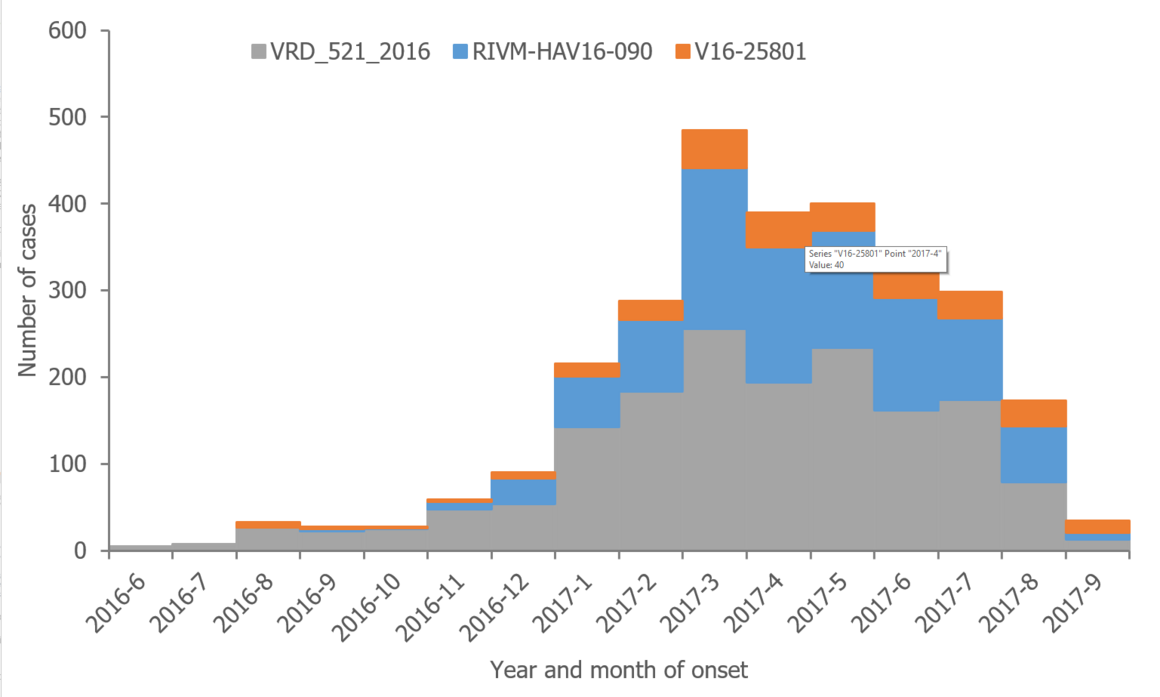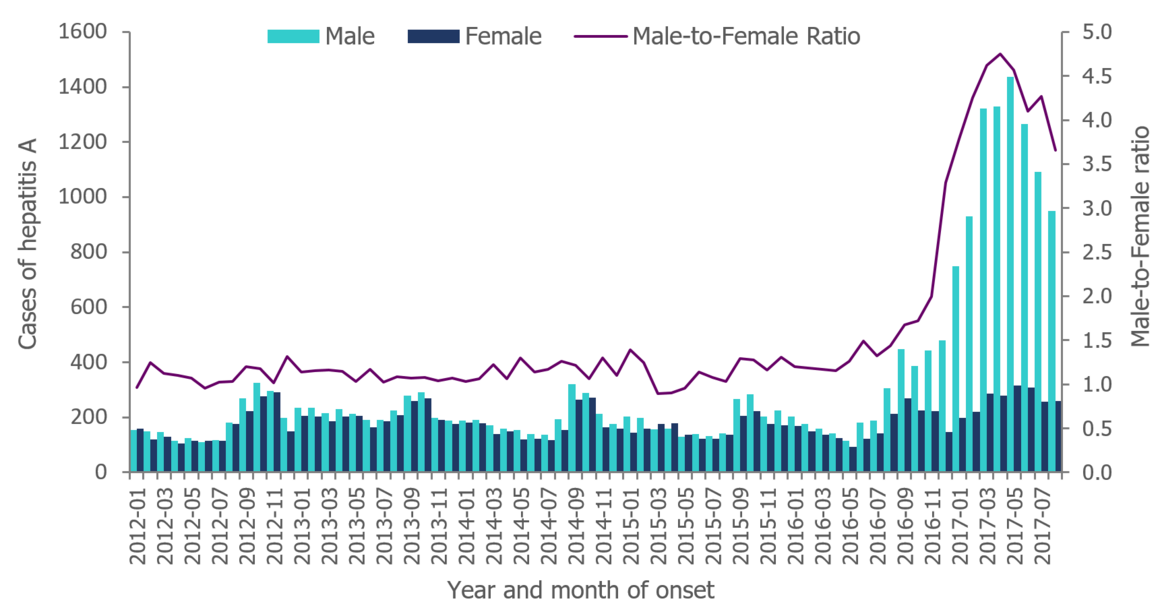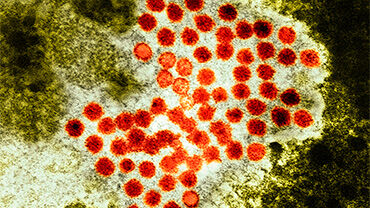Epidemiological update: hepatitis A outbreak in the EU/EEA mostly affecting men who have sex with menArchived
Since the last rapid risk assessment on this multi-country hepatitis A outbreak, 19 EU/EEA countries (Austria, Belgium, Denmark, Estonia, Finland, France, Greece, Ireland, Italy, Latvia, Luxembourg, Malta, the Netherlands, Norway, Portugal, Slovenia, Spain, Sweden and the United Kingdom-England & Wales) have reported 1 363 new outbreak-confirmed cases. Outbreak-confirmed cases are EU/EEA residents with laboratory-confirmed hepatitis A virus (HAV) genotype IA and a sequence with 99.3% homology to one of the three HAV genotype IA outbreak strains (VRD_521_2016; RIVM-HAV16-090; and V16-25801) based on overlapping fragments at the VP1-2a region.
As of 27 September 2017, the number of outbreak-confirmed cases reported in 20 EU/EEA countries since 1 June 2016 is 2 873 (Figure 1). For 2 582 of these cases information on gender is available, with a male to female (M/F) ratio of 9.3. Information on status is available for 970 male cases, 738 of which (76%) were reported as MSM. No other strains were reported to be widely circulating among MSM apart from the three outbreak strains and their close variants, which are captured in Figure 1.
Figure 1. Distribution of hepatitis A outbreak-confirmed cases, by month of onset and genetic sequence, June 2016 to September 2017, as of 27 September 2017, EU/EEA (n=2 863*)

* Where date of onset was unavailable we used date of sampling or date of receipt by the reference laboratory. An additional 16 cases with missing dates are not included. A total of 308 additional cases have sequencing pending in Spain.
Countries included: Austria, Belgium, Denmark, Estonia, Finland, France, Germany, Greece, Ireland, Italy, Latvia, Luxembourg, Malta, the Netherlands, Norway, Portugal, Slovenia, Spain, Sweden and the United Kingdom.
Outbreak-confirmed cases for Germany, Scotland and Spain are reported until June 2017.
The largest number of cases was reported in March 2017. However, there may be substantial reporting delays (weeks or even months) in sequencing information and the number of cases with onset in more recent months is likely to increase once more sequencing results are available, particularly from Spain and Germany.
Outbreak-confirmed cases provide an underestimation of the true extent of the outbreak because sequencing information is only available for a proportion of hepatitis A cases as sampling strategies vary widely from country to country. In 2017, 467 (37%) of the 1 258 laboratory-confirmed hepatitis A case strains in 10 EU/EEA countries (Austria, Belgium, Denmark, Estonia, Greece, Iceland, Luxembourg, the Netherlands, Slovenia and Sweden) were sequenced. Of these 467 sequenced cases, 354 (76%) were infected with one of the outbreak strains.
In order to better define the extent of this outbreak, we describe hepatitis A laboratory-confirmed cases. From January to August 2017, 19 countries (Austria, Belgium, Czech Republic, Denmark, Estonia, Finland, France, Germany, Greece, Ireland, Iceland, Italy, Luxembourg, Malta, the Netherlands, Slovenia, Spain, Sweden and the UK-England & Wales) reported 11 212 laboratory confirmed cases with a M/F gender ratio of 4.3. The highest M/F ratio was 4.8, reported in April 2017. Since then, the number of male cases has decreased, and along with it the male-to-female ratio, although it remains higher than 3.5 (Figure 2).
The 11 212 cases reported from January to August 2017 represent a four-fold increase compared to the average 2 594 cases reported annually for the same period between 2012 and 2015. The year 2016 was excluded from the comparison as the current outbreak was already taking place at the time.
Figure 2. Distribution of hepatitis A cases by gender and male-to-female ratio, January 2012 to August 2017, as of 27 September 2017, EU/EEA*

* Where date of onset was unavailable we used date of sampling or date of receipt by the reference laboratory. The 2017 data from the UK are only for England and Wales and data from April are provisional. Data from Belgium are missing for 2015 and 2016. Countries included: Austria, Belgium, the Czech Republic, Denmark, Estonia, Finland, France, Germany, Greece, Ireland, Iceland, Italy, Luxembourg, Malta, the Netherlands, Slovenia, Spain, Sweden and the United Kingdom.
Poland did not report cases in 2017 but ECDC epidemic intelligence screening identified 1 426 hepatitis A cases in 2017, as of 15 September, compared to 26 cases in 2016, representing a 55-fold increase in cases during 2017 compared to 2016.
ECDC asked EU/EEA countries to report on events that could contribute to the spread of the outbreak strains in population groups at increased risk of infection or in the community. Belgium, France and Germany reported six foodborne clusters of 15 cases on average, associated with one of the outbreak strains in 2017. As a result of these spill-over events, a limited increase has been noted in females, children and the elderly in parallel with the large increase in male cases.
Slovakia reported 13 outbreaks among minority ethnic groups (Roma people) in 2017. However, these cases could not be linked to the outbreak as sequencing information was not available. The Czech Republic and Greece were the only countries observing increases in the number of cases reported in 2017 with similar distribution of cases in males and females. Greece and Italy observed clusters of cases, possibly associated with consumption of contaminated seafood. However, sequencing information was not available to link these clusters to the outbreak strains.
Vaccination
The main prevention measure in this context is hepatitis A vaccination of MSM. Hepatitis A vaccine availability in the EU is currently limited, with some countries having reported shortages (e.g. Austria, Denmark, Italy, Portugal, Spain and Sweden) while the Czech Republic, Estonia, Finland, Germany, Ireland, Luxembourg and Slovenia have not reported any shortages. In addition, since the last update, Malta and some areas of the Netherlands have reported vaccine shortages, while Belgium and Iceland have reported no shortages. It is suggested that vaccination be promoted and offered to MSM attending Pride festivals, where there may be an increased likelihood of contact with hepatitis A-infected individuals. However, limited hepatitis A vaccine availability in some countries may hinder the implementation of these measures.
Since the last ECDC rapid risk assessment in June 2017, Italy, Spain and the United Kingdom have issued new vaccination recommendations.
Assessment
Between June 2016 and September 2017, 20 EU/EEA countries reported 2 873 hepatitis A outbreak-confirmed cases, peaking in March 2017. In addition, hepatitis A laboratory-confirmed cases reported by 19 EU/EEA countries peaked in May 2017 and the related M/F ratio peaked in April 2017. The monthly number of laboratory-confirmed cases and the M/F ratio remain significantly higher than in previous years. Given the reporting delay of outbreak-confirmed cases, these data indicate that the outbreak is still ongoing and that more cases are to be expected in the EU/EEA countries in the future.
The conclusions and options for response set out in ECDC’s rapid risk assessment entitled ‘Hepatitis A outbreak in the EU/EEA mostly affecting men who have sex with men – Third update, 28 June 2017’, remain valid.






